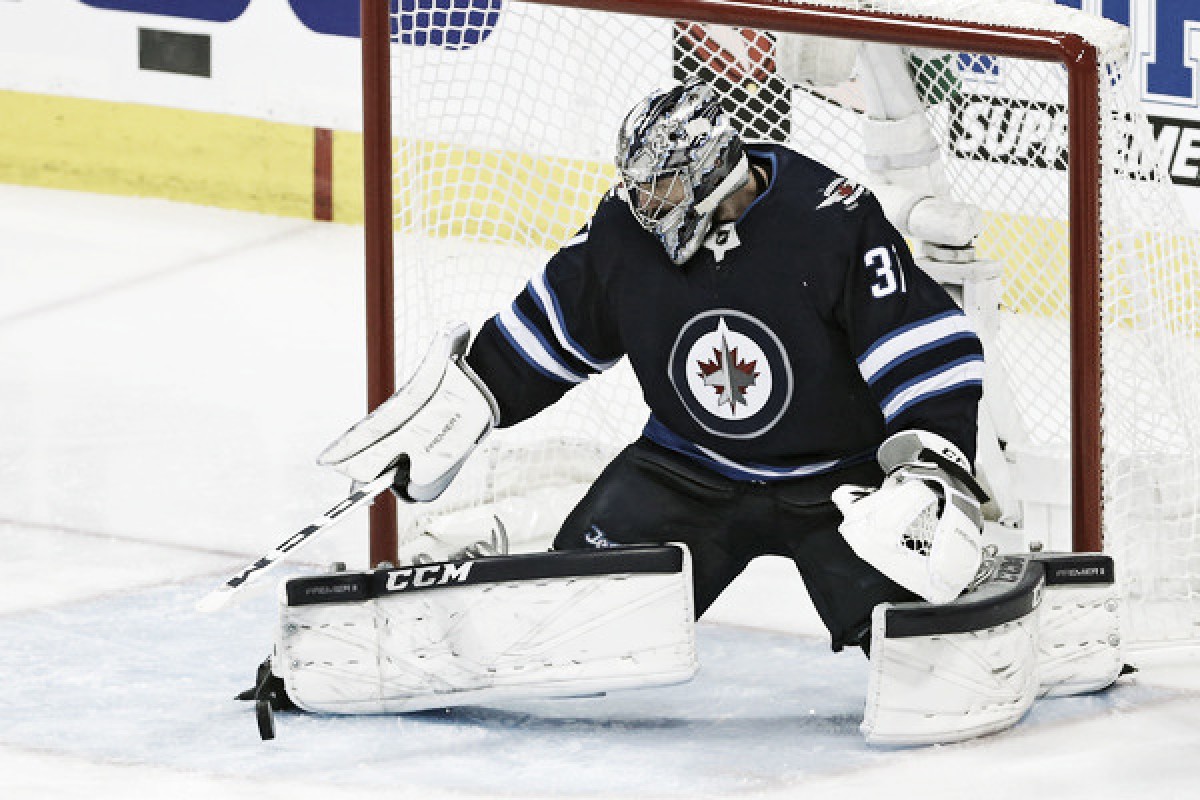The Winnipeg Jets went a long way on Thursday to make sure they remain contenders for the foreseeable future. Coming off a career season in which he led the NHL in wins and was a finalist for the Vezina Trophy, the Jets signed goaltender Connor Hellebuyck to a six-year deal.
Formerly a fifth-round pick back in 2012, Hellebuyck emerged as one of the best young goaltenders in the game this season.
After originally getting the net on a full-time basis last season, Hellebuyck struggled leading Winnipeg to go out and sign Steve Mason to compete for playing time. Mason struggled with injuries all year, but it didn’t matter, as Hellebuyck took off.
The deal is worth a total of $37 million, with an average annual value (AAV) of $6.167 million over six years. It makes him, at the moment, the sixth highest paid goalie in the league in terms of AAV. He is also the youngest of the any of the other goalies in the top ten.
Rise to become a franchise netminder
By the time Hellebuyck heard his name called at the 2012 draft, 12 other goaltenders were selected. The Pittsburgh Penguins themselves drafted not one, but two goalies before the Jets got around to Hellebuyck (to be fair, Matt Murray was one of them, but still.)
It didn’t take long for him to rise to the NHL level, spending two years at UMASS-Lowell before turning pro then he spent the next year and a half in the American Hockey League (AHL). He spent the 2015/16 season in a three-way goaltender split along with Ondrej Pavelic and Micheal Hutchinson with no one playing more than 33 games.
2017/18 season
Hellebuyck entered the season expecting to split time with Mason, the Jets’ big free agent acquisition. Injuries limited the former Columbus Blue Jacket and Philadelphia Flyer to just 13 games and he was ineffective in his short-time in a Jets' jersey when healthy.
Mason’s injuries, ineffective play, and with some adjustments to his game, opened the door for Hellebuyck’s breakout season as the netminder was named to his first All-Star Game and finished in a tie with Andrei Vasilevskiy for the most wins in the league.
Also due to a lack of a backup, Hellebuyck also led all goaltenders in games played (67) and total minutes (3,966). Along with his 44 wins, Hellebuyck posted top ten numbers in both goals-against-average (GAA), and save percentage (SV%).
Hellebuyck was one of three finalists for the Vezina Trophy given to the best goaltender in the league along with Pekka Rinne and Vasilevskiy. Only Rinne and Hellebuyck received multiple first-place votes as the Nashville Predators’ goaltender ended up with the award.
The contract and beyond, cause for concern?
As stated above, the contract makes Hellebuyck the sixth highest paid goaltender, in terms of AAV. He’s also the youngest in the group, but after playing 67 games in the regular season, along with going to the Conference Finals, could he be in line for a bit of regression?
TSN put out an interesting piece on paying goaltenders or the league’s lack of ability to do so correctly. It basically goes through the unpredictability of the goaltender position, even from the goalies thought to be ‘elite’ due to their cap hit.
While Hellebuyck’s surface numbers are good (2.36 GAA, .924 SV%), there some outliers that could be of concern. When it comes down to it, for as good as he was last season, some of the numbers would actually suggest he wasn’t tested that much and when he was, Hellebuyck didn’t come through as much as you would hope.
When it comes to 5v5 play, Hellebuyck faced the second most shots-per-60 minutes played among all goalies with at least 2,500 minutes at even strength. The shots he did face weren’t in great places either as only 15.13% of them were in the ‘high-danger’ zone, the third lowest percentage among the same group of goalies.
His save percentage in ‘medium-danger’ and ‘high-danger’ ranked the sixth and eighth lowest, respectively, in the league.
He stopped what he was supposed to and enough of the others to still rank fourth in overall save percentage. His expected save percentage (xSV%), which determines what a goalies SV% SHOULD be based on the quality of shots he faced was the second-best in the league, just behind Devan Dubnyk.
Hellebuyck’s actual SV% was better than his xSV%, which is a positive sign - meaning he stopped more pucks than what was expected of him at even strength - but the fact remains, among some the goalies with heavier workloads, he was actually tested few than others.
Speaking of goaltender workloads
| Player | Min | GA | SV% | GAA | Min | GA | SV% | GAA |
| Hellebuyck | 3965 | 156 | .924% | 2.36 | ? | ? | ? | ? |
| Cam Talbot | 4294 | 171 | .912% | 2.39 | 3730 | 188 | .908% | 3.02 |
| Jonathan Quick | 4034 | 169 | .918% | 2.22 | 931 | 35 | .917% | 2.26 |
| Braden Holtby | 4247 | 157 | .923% | 2.22 | 3841 | 141 | .923% | 2.20 |
| Kari Lehtonen | 3803 | 153 | .919% | 2.41 | 3698 | 181 | .903% | 2.94 |
| Antti Niemi | 2580 | 93 | .924% | 2.16 | 3740 | 149 | .913% | 2.39 |
*Table numbers courtesy of NHL.com
Above, listed are the goalies who led the league in minutes played in each of the last five seasons with their numbers that specific year and then what they did as an encore.
Disregarding certain circumstances - Quick missing time due to injury and the lockout-shortened season in which Niemi led the NHL in minutes played - almost every goalie took a step back the following year.
However, regardless of the situation, four of the five goalies saw an increase in their GAA and a decrease in their SV% the following season. The only outlier in both was Braden Holtby, who actually won the Vezina Trophy in his follow up year.
Holtby finished fourth in the voting before winning it the next year and Hellebuyck was the runner-up. Their stats aren’t that far apart so Hellebuyck could actually be that exception once again, but recent odds haven’t been in his favor.
The Jets are banking on Hellebuyck after just one good season. All though it was a franchise record-setting season (admittedly not hard considering they use to call themselves the Thrashers,) there is a lot of risk in signing him to that contract.
History has shown that there are going to be years that Hellebuyck struggles during this contract, it’ll be up to the Jets’ defense to keep playing great in front of him in those times.
Whatever the numbers say, this was a signing that the Jets had to make. Getting Hellebuyck under contract was maybe the most important thing Winnipeg had to do.
For six-years, just over $6 million per year, a goalie that is just 25, took the team to a Conference Finals and was a Vezina Trophy runner-up, it was a win for all sides as long as the risk is known going into it.
How do you feel about the Hellebuyck contract? Was it a necessary move for the Jets to continue to be a contender? Or should they have waited to sign him to a long-term contract? Let us know what you think in the comment section below!










































